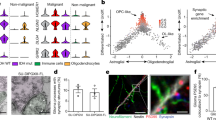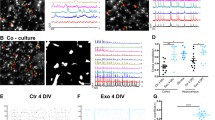Summary
We have studied the ion flux through the sodium channels of low passage number (<50p.) and high passage number (>150p.) neuroblastoma x glioma hybrid cells using [14C] guanidinium and specific neurotoxins to induce channel opening and closing. The sodium channels of low passage number hybrid cells could be opened by veratridine alone, suggesting the presence of voltage dependent channels in agreement with electrophysiological studies reported in the literature. The sodium channels of the high passage number hybrid cells, however, needed the synergistic action of veratridine and scorpion toxin for activation suggesting that these channels are “silent”. The [14C] guanidinium ion flux through the sodium channels of the high passage number hybrid cells was inhibited by significantly lower concentrations of the volatile anesthetics (halothane, isoflurane and enflurane) and the lcoal anesthetics (tetracaine and bupivacaine) than the comparable flux through the sodium channels of the low passage number hybrid cells.
Similar content being viewed by others
References
Bean BP, Shrager P, Goldstein DA (1981) Modification of sodium and potassium channel gating kinetics by ether and halothane. J Gen Physiol 77: 233–253
Catterall WA (1975) Activation of the action potential Na+ ionophore of cultured neuroblastoma cells by veratridine and batrachotoxin. J Biol Chem 250: 4053–4059
Catterall WA, Nirenberg M (1973) Sodium uptake associated with activation of action potential ionophores of cultured neuroblastoma and muscle cells. Proc Natl Acad Sci USA 70: 3759–3763
Courtney KR (1980) Structure-activity relations for frequency dependent sodium channel block in nerve by local anesthetics. J Pharmacol Exp Ther 213: 114–119
Creveling CR, McNeal ET, Daly JW, Brown GB (1983) Batrachotoxin-induced depolarization and3H Batrachotoxinin-A 20 benzoate binding in a vesicular preparation from guinea pig cerebral cortex. Mol Pharmacol 23: 350–358
Diamond BI, Havdala HS, Sabelli HC (1975) Differential membrane effects of general and local anesthetics. Anesthesiology 43: 651–660
Drummond JC (1985) MAC for halothane, enflurane and isoflurane in the New Zealand white rabbit: and a test for the validity of MAC determinations. Anesthesiology 62: 336–338
Evers AS, Berkowitz BA, D'Avignon DA (1987) Correlation between the anaesthetic effect of halothane and saturable binding in brain. Nature 328: 157–160
Franks NP, Lieb WR (1984) Do general anesthetics act by competitive binding to specific receptors. Nature 310: 599–601
Frelin C, Vigne P, Schweitz H, Lazdunski M (1984) The interaction of sea Anemone and scorpion neurotoxins with tetrodotoxin-resistant Na+ channels in rat myoblasts. A. comparison with Na+ channels in other excitable and non-excitable cells. Mol Pharmacol 26: 70–74
Hamprecht B (1977) Structural, electrophysiological, biochemical and pharmacological properties of neuroblastoma x glioma cell hybrids in the culture. Int Rev Cytol 49: 99–170
Haydon DA, Urban BW (1983) The effect of some inhalation anaesthetics on the sodium current of the squid giant axon. J Physiol 341: 429–439
Hille B (1972) The permeability of the sodium channel to organic cations in myelinated nerve. J Gen Physiol 58: 599–519
Jacques Y, Fosset M, Lazdunski M (1978) Molecular properties of the action potential Na+ ionophore in neuroblastoma cells. Interaction with neurotoxins. J Biol Chem 253: 7383–7392
Littlefield JW (1964) Selection of hybrids from matings of fibroblasts in vitro and their presumed recombinants. Science 145: 709–710
Lowry OH, Rosebrough NJ, Farr AL, Randall RJ (1951) Protein measurement with Folin phenol reagent. J Biol Chem 193: 265–275
Munson R Jr, Westermark B, Glaser L (1979) Tetrodotoxin-sensitive sodium channels in normal human fibroblasts and normal human glia-like cells. Proc Natl Acad Sci USA 76: 6425–6429
Postma SW, Catterall WA (1984) Inhibition of binding of3H Batrachotoxinin-A 20 — benzoate to sodium channels by local anesthetics. Mol Pharmacol 25: 219–227
Pouysségur J, Jacques Y, Lazdunski M (1980) Identification of a tetrodotoxin sensitive Na+ channel in a variety of fibroblast lines. Nature 286: 162–164
Reiser G, Löffler F, Hamprecht B (1983a) Tetrodotoxin-sensitive ion channels characterized in glial and neuronal cells from rat brain. Brain Res 261: 335–340
Reiser G, Günther A, Hamprecht B (1983b) Blockade by neurotransmitter antagonists of veratridine-activated ion channels in neuronal cell lines. J Neurochem 40: 493–502
Reiser G, Günther A, Hamprecht B (1982) Strychnine and local anesthetics block ion channels activated by veratridine in neuroblastoma x glioma hybrid cells. FEBS Lett 143: 306–310
Reiser G, Hamprecht B (1983) Sodium channels in non-excitable glioma cells, shown by the influence of veratridine, scorpion toxin, and tetrodotoxin on membrane potential and ion transport. Pflügers Arch 397: 260–264
Renaud JF, Romey G, Lombet A, Lazdunski M (1981) Differentiation of the fast Na+ channel in embryonic heart cells: interaction of the channel with neurotoxins. Proc Natl Acad Sci USA 78: 5348–5352
Romey G, Jacques Y, Schweitz H, Fosset M, Lazdunski M (1979) The sodium channel in non-impulsive cells. Interaction with specific neurotoxins. Biochim Biophys Acta 556: 344–353
Tas PWL, Kress HG, Koschel K (1985) Halothane inhibits the neurotoxin stimulated14C guanidinium influx through “silent” sodium channels in rat glioma C 6 cells. FEBS Lett 182: 269–272
Tas PWL, Kress HG, Koschel K (1987) General anesthetics can competitively interfere with sensitive membrane proteins. Proc Natl Acad Sci USA 84: 5972–5975
Tomozawa Y, Sueoka N, Miyake M (1985) Clonal sublines of neurotumor RT4 and cell differentiation. V. Comparison of Na+ influx, Rb+ efflux and action potential among stem-cell neuronal, and glial cell types. Dev Biol 108: 503–512
Author information
Authors and Affiliations
Additional information
Dedicated to Prof. Dr. E. Wecker on the occasion of his 65th birthday.
Rights and permissions
About this article
Cite this article
Tas, P.W.L., Kress, H.G. & Koschel, K. The sodium channels of the neuroblastoma x glioma 108 CC 15 hybrid cell change their sensitivity for volatile and local anesthetics upon continuous passage. J. Neural Transmission 76, 99–107 (1989). https://doi.org/10.1007/BF01578750
Received:
Accepted:
Issue Date:
DOI: https://doi.org/10.1007/BF01578750




